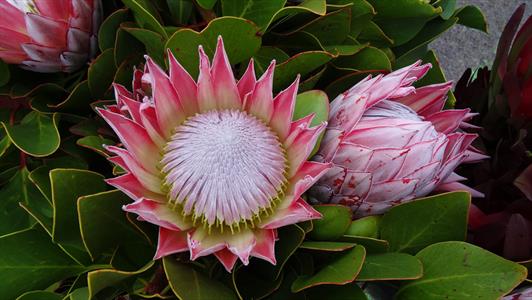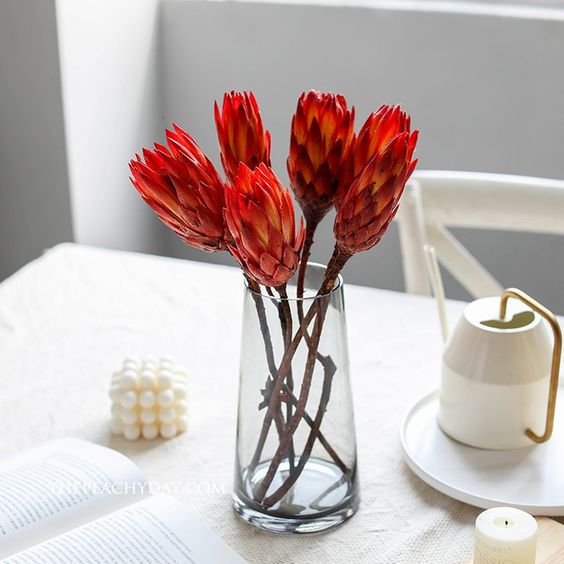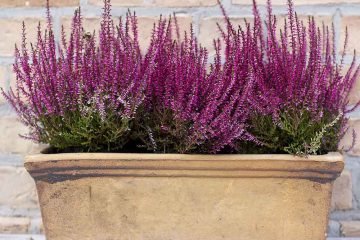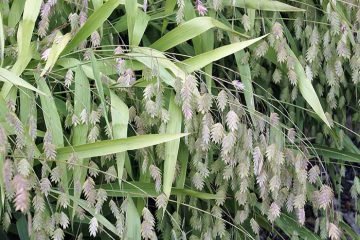protea flower
Protea flower specifications
- Scientific name : Protea Repens
- Order : Proteales
- Family : Proteaceae
- Genus : Protea
- Species : P. repens
- Sun Exposure : Full sun
- Soil Type : Sand or loam that is very well-drained
- Bloom Time : Late winter and spring
- Bloom Color : Pink, white, cream
- Native Area : South Africa
Coming from the Proteaceae family, the Protea genus includes more than 1,000 species. Consider welcoming protea plants to your outdoor space if you are a seasoned gardener in a warm, dry climate. These evergreens can grow low as shrubs or tall as trees depending on the variety.
Goblet-shaped flowers bloom in large clusters with fluffy centers surrounded by bracts that are bright and spiky. Be aware that protea flowers, nectar, and seeds are toxic to humans and pets.
read more : Everything about bongardia flower : How to Plant & care for them

Protea repens, known as the common sugarbush and in Afrikaans as the suikerbossie, is an erect shrub growing in the southern regions of South Africa. Related to other proteas, this plant is a relatively adaptable and variable species and can be found growing widely in various soils.
Description
Protea repens is a dense shrub growing between 1 to 4 metres (3 ft 3 in to 13 ft 1 in) in height. The inflorescences, ranging in colour from deep red to a creamy white, are borne at the end of the branch, often nestled between two growing branchlets.
Habitat
This species grows widely in fynbos on a variety of soils. Like many other Protea species, P. repens is adapted to an environment in which bushfires are essential for reproduction and regeneration.
Most Protea species can be placed in one of two broad groups according to their response to fire : reseeders are killed by fire, but fire also triggers the release of their canopy seed bank, thus promoting recruitment of the next generation; resprouters survive fire, resprouting from a lignotuber or, more rarely, epicormic buds protected by thick bark.
P. repens is a reseeder, where its life cycle depends on its seeds which may have been stored underground by ants or remained on the old flowerheads.
read more : Everything about scabiosa flower : How to Plant & care for them
Protea Plant Care
Protea thrive in regions with hot and sunny climates where many other types of flowering plants might not survive. Their thick, hard leaves enables them to survive in quite harsh conditions.
 Light
Light
Provide plants with lots of air circulation and full sun—the more sun, the more flowers.
 Soil
Soil
Protea plants need very well-draining soil. If the soil drains well, they will thrive in just about any type of soil, from sandy, rocky, or loamy. The plant’s roots can grow almost horizontally, just below the soil surface, making them ideal plants for a rocky part of the garden. Avoid letting water sit on the soil because the roots can become waterlogged, likely causing the plant to die. When planting proteas outdoors, increase drainage by mixing bark and grit into the soil.
 Water
Water
While plants are starting to become established, water them regularly. Water established plants just every two to three weeks. After the plant is about a year old, water once a week when the weather is dry and when it sets buds and flowers.
read more : Everything about phalaris plant : How to Plant & care for them
 Temperature and Humidity
Temperature and Humidity
When planted in the correct climate and hardiness zone noted for the specific variety, proteas can tolerate temperatures as low as 23 degrees Fahrenheit (sometimes lower). They can also tolerate temperatures as hot as 100 degrees Fahrenheit, but can die if exposed too long to temperatures any higher. Avoid planting proteas in particularly humid zones.
 Fertilizer
Fertilizer
Proteas usually don’t need fertilizer. Too much phosphorus can actually kill them. Because the roots are so shallow, take extra care not to disturb them. Apply a mulch of leaves or bark away from the trunk. Gently pull any weeds by hand.
Types of Protea Plants
‘King Protea’ (Protea cynaroides L.), which resembles a crown, and symbolizes beauty and resilience, is a well-known member of this genus (and South Africa’s national flower). ‘King Protea’ has yellow and red flowers with pink outer tips. One popular compact variety is protea ‘Little Prince’, and another beloved type of protea that blooms bountifully is called ‘Special Pink Ice’.
Most protea plants do not self-pollinate. However some close cousins in the Leucospermum and Serruria genus can self-pollinate and produce seed.
- Leucospermums are also called pin-cushion proteas because their flowers curve upwards. Grow them as low shrubs in the ground or welcome them to a planter arrangement in wide shallow containers. If you live in a more temperate zone such as a cooler mountain region or on the coast, this type of protea may be best for your garden.
- Serrurias protea include the cultivars ‘Blushing Bride’, which produces gorgeous creamy flowers, and ‘Pretty in Pink’, the flowers of which are thought to resemble pink-cheeked bridesmaids. Serruria protea plants grow well in well-draining containers, though they might not last more than one or two seasons.
read more : Everything about lagurus plant : How to Plant & care for them
Pruning protea plants
Bold in color and lush in shape and texture, protea flowers are wonderful for fresh bouquets and for dried arrangements. Harvesting the flowers helps keep the plant neat. Remove spent flower heads along with most of the stem, allowing for new growth. To encourage bushiness, prune young plants in spring and summer. Do not prune unflowered stems; they are next season’s blooms.
Potting and Repotting
For potted proteas, mix even parts peat, gravel, and sand. They do well in nutrient-poor soil.
Common Pests and Plant Diseases
Proteas are quite resistant to pests. These woody evergreens are neither herbaceous nor annual. Leaves are large, hard, and leathery. When bent, a mature leaf tends to snap rather than fold. Because the leaves have adapted to conserve water, resist drought, and hold carbon and nitrogen, most insect pests tend to avoid them.
Iran dried protea flower
If you want to create a dreamy atmosphere, the use of dried protea flower is highly recommended. These dried flowers, while beautiful, is completely recyclable in nature and will always look beautiful in your space without being destroyed. The reasonable price of dried protea flower has made the sale and purchase of dried Protea flower a great profit for the wholesalers and exporters of dried Protea flower .
To dry them for flower arrangements, simply pick them at their brightest and biggest, snip off the bottom leaves, and hang them upside-down indoors in a dark place with decent air circulation for about two weeks. Because they bloom in late winter to spring, some gardeners include them in holiday wreaths.

read more : Drying natural flowers | Introducing 8 wonderful ways to dry flowers
FAQ protea flower
Can protea plants be grown indoors?
In the United Kingdom, some gardeners have had success moving protea plants indoors in the cooler months and covering them with fleece until late spring.
What are alternatives to protea plants?
When exploring other flowers that bloom as fully and as vibrantly, consider football or cremone mums. Zinnias also offer a range of color, texture, and shape. Leucadendrons are very closely related to proteas. Commonly called cone bush, flowers are shaped like tulips and the foliage tends to be very bright in color. ‘Safari Sunset’ offers a vibrant red aesthetic and ‘Inca Gold’ comes in mellow yellow. Newer varieties include ‘Burgundy Sunset’ and ‘Gypsy Red’.
How long will a protea flower last in a vase?
They will last one or two weeks at most in optimal conditions.



0 Comments